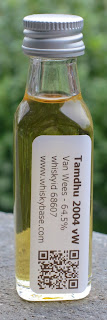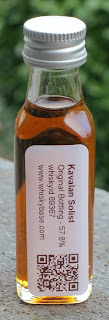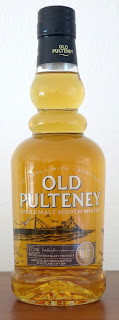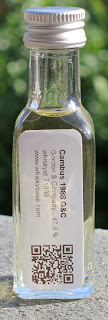This whisky was distilled in 1997, then bottled in 2012 at 52.8% without coloring or chill filtration.
 The First Editions Clynelish 14 Year 1997/2012 Cask ES 009/03
The First Editions Clynelish 14 Year 1997/2012 Cask ES 009/03Nose: very malty, hints of sherry around the edges, vanilla, very mild oak, graham crackers, beeswax, a little vegetal. After adding a few drops of water it becomes more malty and less sherried.
Taste: moderate malt and sherry sweetness throughout, honey, vanilla, and something vegetal starting around the middle, the sherry trends towards red wine with oak and black pepper spice at the back. After dilution the malt and sherry integrate and become buttery/creamy, while the spiciness at the back is toned down.
Finish: spicy oak, lingering sherry, malt, drying
My guess is that this was a second-fill sherry cask, probably made from American oak. It isn't a bad whisky, just a little disappointing. Despite the sherry cask not being too active, there isn't as much of the trademark Clynelish character I was hoping for. The nose eventually opened up into something decent, but the palate was kind of flat in comparison. A lot of this perked up right at the end, but getting through the bottle was a bit of a struggle because it almost never gripped me.
Diluted to 50%
Nose: clean malt, light sherry, a whiff of alcohol, biscuit-y, creamy vanilla, slightly tired oak, a little vegetal, a hint of baking spices
Taste: fairly sharp - dry, slightly bitter malt and thick sherry throughout, briefly sweet up front, becoming tannic around the middle, fading through more rounded sherry plus a little waxiness, pepper, and orange peel at the back
Finish: sherry residue, oak tannins, bittersweet malt, pepper
For whatever reason this dilution really doesn't work for me. It takes some of the heat out, but the smells and flavors are even more muddled and without many redeeming qualities besides a certain thickness to the sherry on the palate. Good thing this wasn't bottled in the Old Malt Cask series.
Diluted to 45%
Nose: fairly light - balanced malt and sherry, juicy berries, floral notes in the background, waxy, digestive biscuits, a little green, vanilla
Taste: creamy balanced malt and sherry sweetness throughout, gets a little sour with a decent dose of vanilla and a little wax starting in the middle, gentle green peppery oak with a little tropical fruit coming in near the back
Finish: gentle peppery oak, malty, sherry residue
Unlike some other malts, this remained rather consistent throughout the different stages of dilution. My notes from the full strength whisky read very similarly to those at 45%, though dilution did transform it into a much easier drinking malt. In a lot of ways I think it would have been better or being bottled at 46%, since this creates a much more balanced experience than I found at either full strength or at 50%.






























